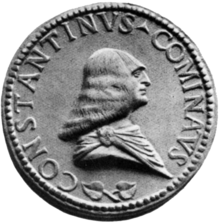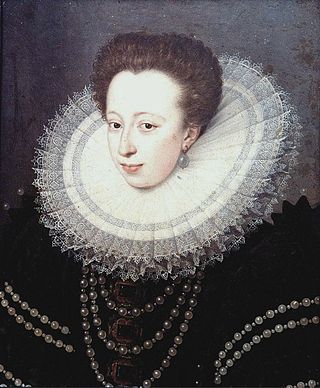
Christina of Lorraine was a French noblewoman of the House of Lorraine who became a Grand Duchess of Tuscany by marriage. She served as Regent of Tuscany jointly with her daughter-in-law during the minority of her grandson from 1621 to 1628.

Christina of Denmark was a Danish princess, the younger surviving daughter of King Christian II of Denmark and Norway and Isabella of Austria. By her two marriages, she became Duchess of Milan, then Duchess of Lorraine. She served as the regent of Lorraine from 1545 to 1552 during the minority of her son. She was also a claimant to the thrones of Denmark, Norway and Sweden in 1561–1590 and was sovereign Lady of Tortona in 1578–1584.

Virginia de' Medici was an Italian princess, a member of the House of Medici and by marriage Duchess of Modena and Reggio.

Gjergj Arianiti (1383–1462) was an Albanian feudal lord who led several successful campaigns against the Ottoman Empire. He was the father of Donika, Skanderbeg's wife, as well as the grand-uncle of Moisi Arianit Golemi. Gjergj Arianiti was Skanderbeg's ally within League of Lezhë before abandoneding the alliance after the defeat in Berat in 1450. He later returned. Robert Elsie emphasizes that Arianiti was often Skanderbeg's rival. He allied with the Kingdom of Naples in 1446, left his alliance with Skanderbeg by 1449 and allied with Venice in 1456. However his daughter married Skanderbeg and he remained officially part of the League of Lezhe, continuing to fight Ottomans successfully up to his death in 1462.

Vittoria della Rovere was Grand Duchess of Tuscany as the wife of Grand Duke Ferdinando II. She had four children with her husband, two of whom would survive infancy: the future Cosimo III, Tuscany's longest-reigning monarch, and Francesco Maria, a prince of the Church. At the death of her grandfather Francesco Maria della Rovere, she inherited the Duchies of Rovere and Montefeltro, which reverted to her second son, Francesco Maria, at her death. She was later entrusted with the care of her three grandchildren. Her marriage brought a wealth of treasures to the House of Medici, which can today be seen in the Palazzo Pitti and the Uffizi Gallery in Florence.

Isabella Clara of Austria was a Duchess consort of Mantua, Montferrat, Nevers, Mayenne and Rethel by marriage to Charles II, Duke of Mantua and Montferrat.

Cristina Trivulzio di Belgiojoso was an Italian noblewoman, the princess of Belgiojoso, who played a prominent part in Italy's struggle for independence. She is also notable as a writer and journalist.
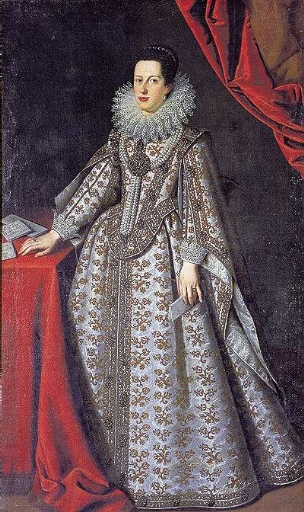
Caterina de' Medici was a Tuscan noblewoman of the Medici family. She became Duchess of Mantua and Montferrat as the second wife of Duke Ferdinando and Governor of Siena from 1627. She was the second daughter of Grand Duke Ferdinando I of Tuscany and his wife Christina of Lorraine.

The House of Tocco was an Italian noble family from Benevento that came to prominence in the late 14th and 15th centuries, when they ruled various territories in western Greece as Counts Palatine of Cephalonia and Zakynthos and Despots of Epirus. During their brief period of rule in Greece, they were one of the most ambitious and able Latin dynasties in the region, and they were one of the few to leave descendants lasting until modern times.
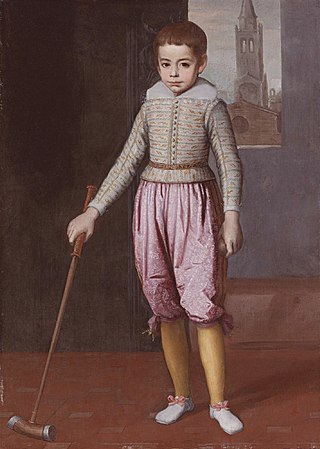
Federico Ubaldo della Rovere was Duke of Urbino from 1621 to 1623. He was father of Vittoria della Rovere, Grand Duchess of Tuscany.

Isabella Gonzaga, was an Italian aristocrat. She was Lady Consort of San Martino dall'Argine by marriage to Ferrante Gonzaga, Lord of San Martino dall'Argine, and Duchess consort of Mantua and Montferrat by marriage to Vincenzo II Gonzaga, Duke of Mantua. She served as regent of San Martino dall'Argine during the minority of her son Scipione between 1605 and 1613.

William IX Palaeologus was Marquis of Montferrat from 1494 until his death. He was a member of the House of Palaeologus-Montferrat, a cadet branch of the Palaiologos dynasty which had once ruled the Byzantine Empire.
Carlo III Tocco (1464–1518) was the titular despot of Epirus and count palatine of Cephalonia and Zakynthos from the death of his father Leonardo III Tocco c. 1503 to his own death in 1518. Carlo lived in Rome, where he received pensions from both the Papacy and the Kingdom of Naples. As an adult, Carlo worked as a military officer, serving both the Papacy and Emperor Maximilian I.
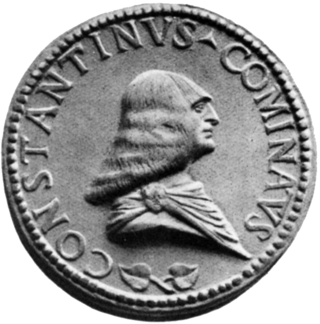
Constantine Cominato Arianiti also known as Constantine Komnenos Arianites, was a 15th and 16th-century Albanian nobleman, military leader, diplomat and pretender who lived most of his life in exile in Italy due to the conquest of his homeland by the Ottoman Empire. Constantine sought to establish himself as a leader among the Christian Balkan refugees in Italy and claimed lordship over various former Christian lands in Greece, using the titles Prince of Macedonia, Duke of Achaea and Despot of the Morea.
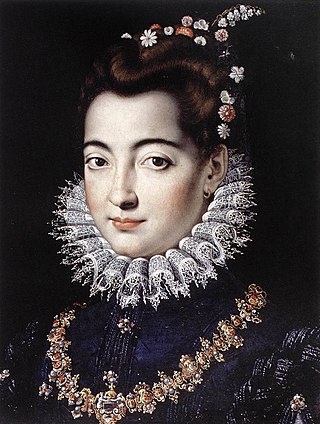
Clelia Farnese, was an Italian noblewoman, member of the House of Farnese, and by her two marriages Marchioness of Civitanova and Lady of Sassuolo. According to contemporaries, she was one of the most beautiful women of her time. She ruled as regent of the Lordship of Sassuolo during the absence of her second spouse Marco III Pio di Savoia, Lord of Sassuolo.
Leonardo IV Tocco was the titular Despot of Epirus and Count Palatine of Cephalonia and Zakynthos from the death of his father Carlo III Tocco in 1518 to his own death in 1564. His mother was Andronica Arianiti, daughter of Constantine Arianiti, also a claimant to various lands in Greece. From his maternal grandfather, Leonardo was granted the fortress of Refrancore, which he held under the title signore (lord).
Arianitto Cominato Arianiti was a 16th-century Italian nobleman of Albanian descent, the only son of the diplomat and pretender Constantine Arianiti. After his father's death in 1530, Arianitto continued Constantine's pretensions, styling himself as the 'Prince of Macedonia', but dropping the other titles used by his father. He served as a captain in the papal army in Rome until his death in battle in 1551, which ended the male line of the Arianiti family in Italy.
Francesco Tocco was the titular Despot of Epirus and Count Palatine of Cephalonia and Zakynthos from the death of his father Leonardo IV Tocco in 1564 to his own death in 1596. He served as infantry captain in the army of the Republic of Venice.
Don Fernando Palaiologos or Paleologo was a 15th and 16th-century nobleman of Greek descent who lived in Italy. After the death of Andreas Palaiologos in 1502, Fernando claimed the title of Despot of the Morea. Though Andreas Palaiologos is generally believed to have been childless, Fernando might have been his son, though possibly illegitimate, and through Andreas possibly a grandnephew of Constantine XI Palaiologos, the final Byzantine emperor.
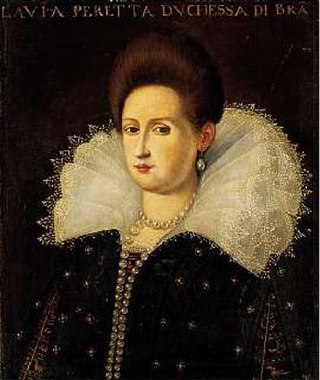
Flavia Damasceni Peretti, Duchess of Bracciano was an Italian noblewoman, niece of Pope Sixtus V and duchess consort of Bracciano as wife of Virginio Orsini. She is also known as the patroness of several poets, writers and musicians.
